The Phanteks Enthoo Pro Case Review
by E. Fylladitakis on March 30, 2015 8:00 AM EST- Posted in
- Cases/Cooling/PSUs
- Full-Tower
- Case
- Phanteks
The Interior of the Phanteks Enthoo Pro
Phanteks placed a lot of thought and resources while designing the interior of the Enthoo Pro. With the exception of the white stock fan blades, everything else in the case is black. A very wide opening on the motherboard tray allows for the installation of advanced CPU coolers without having to remove the motherboard. The opening is so large that if the user were to install an ITX motherboard, the board would barely cover about 60% of it, leaving a large gap to its right side. Flex-ATX and Mini-ATX motherboards will leave a small opening to their right as well. Many cable openings surround the motherboard tray, all covered with rubber grommets.
A cover for the PSU compartment is a rare addition. It has no real function other than the aesthetic upgrade but it is certain that modders will appreciate its presence. The compartment has two openings, a large one on the motherboard tray and a smaller one at the front of the cover, both covered by rubber grommets. The PSU sits on six soft feet that will absorb any vibrations. The installation of the cover is optional, allowing the user to showcase their PSU or install it with its fan facing upwards if need be, as well as to make compatible the case with fanless PSU designs.
Another interesting feature of this case is the mounting points of the fans. Most mounting points do not have screw holes but "rails", allowing the adjustment of the fan's position. The most visually obvious example is the mounting point of the rear 140mm fan, which allows the fan to move as much as four centimeters higher than its original position. This is true for every fan mounting point of the case - only the movement tolerance differs.
A large metallic wall conceals the two HDD cages and forms the three 5.25" bays. Plastic mechanisms lock the 5.25" devices in place and screws can be used for a more permanent installation. A metallic badge with the company logo can be seen near the bottom of the wall and that will be virtually the only thing visible from the front window of the side panel. The HDD cages can be removed to increase the clearance for expansion cards from 34.7cm to 47cm; however, the sidewall may be blocking the power connectors of the card if they are on the side.
The two HDD cages are removable from the right side of the case. Each cage can hold up to three devices, which can be either 3.5" or 2.5" drives, and has a foam pad at the rear to ensure that no vibrations are being transferred to the sidewall of the case. The drive trays are interesting, offering tool-less installation for 3.5" drives via winged pegs that snap at the sides through anti-vibration rubber rings. Optionally, screws can be used to secure 3.5" drives on the tray. The use of screws is obligatory for 2.5" devices, which obviously cannot be secured using the winged pegs.
The rear of the motherboard tray is spacious and outstandingly well designed. Phanteks installed cable ties across the two cable paths that should reduce the time of cable management significantly and keep everything very tidy. The only problem is that the CPU 12V power cable needs to be very long (or an extension needs to be used) in order to reach the top left side of the motherboard.
Two 2.5" drive trays can be installed to the right side of the case but only one tray is supplied and the second is optional - which is very strange, as the cost of a metallic tray should be very small compared to the hassle this creates for everyone that has more than one SSD. A very basic but usable fan controller can be seen as well, which may be used to control up to six cooling fans, including that of the CPU cooler.
The fan controller connects to the CPU fan power header and, essentially, it just copies the PWM signal of the CPU fan header and uses it to adjust the speed of five more fans. It requires additional power from a SATA connector. This approach may be a little dangerous, as it controls the speed of the connected fans using the PWM signal of the CPU header alone - if the CPU is being kept cool by a very advanced cooling system, connecting fans that cool other components or all of the case's fans to the controller could result to overheating or stability problems.
By far the greatest feature of the Phanteks Enthoo Pro is nothing else but the chassis itself. The panels and parts of the chassis are not permanently bolted to each other - screws are holding the case together and it can be dismantled entirely if needed. For the average user, the ability to dismantle the case probably means nothing; however, this is a very rare ability that will surely drive the imagination of modders wild.
Black cables and parts are easily hidden inside an all-black chassis; therefore, for visual clarity, we are using an AX760i PSU with a red cable pack and white SATA cables for our pictures. Building a system inside the Phanteks Enthoo Pro is a very easy, as the case is very spacious and the cable management becomes an admirably easy process. It takes no more than a few minutes to assemble a basic system inside the Enthoo Pro, but we feel that its spaciousness will mostly be appreciated by those with systems that are more complex. We could not find any sharp or otherwise dangerous spots in or around the Enthoo Pro during our experience with it.
There is plenty of clearance between the components and parts of the case, allowing the cables to turn without too much tension and providing enough space for the installation of AIO cooler radiators. With a little careful cable routing, even an amateur can easily build a very tidy and visually pleasing system. The only concerning issue is the required length of the 12V power connector. As seen from our pictures, the cable of the AX760i was not long enough to reach the top right side of the motherboard, even though we ignored the predetermined cable path and went for the opening in a straight line. An extension cable is likely going to be necessary for the majority of users.


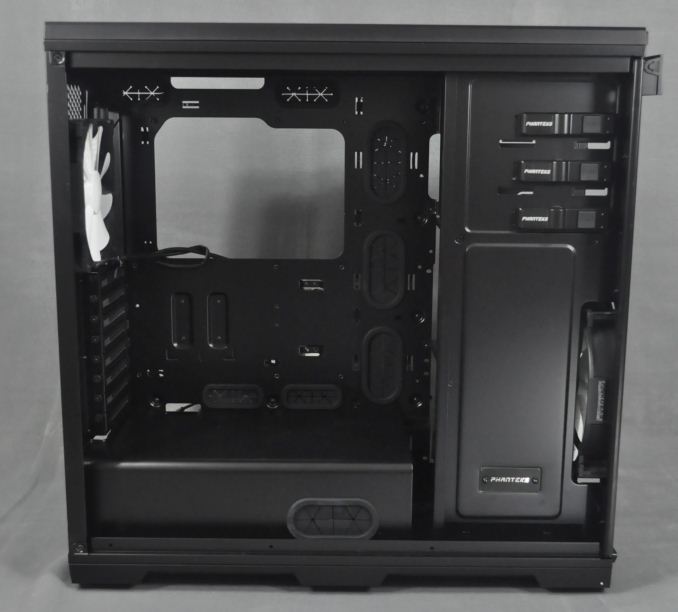
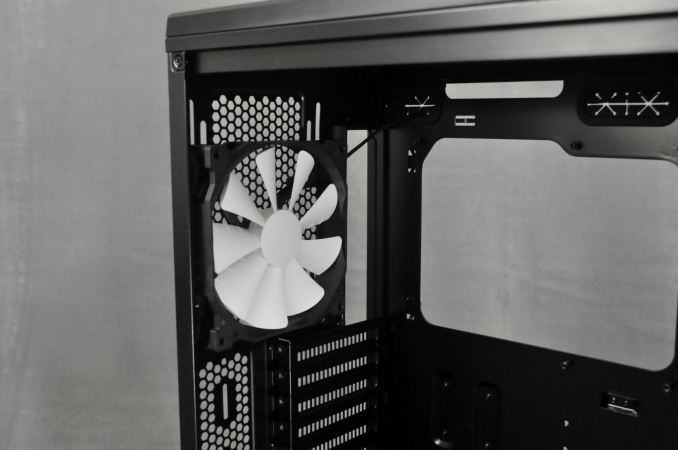
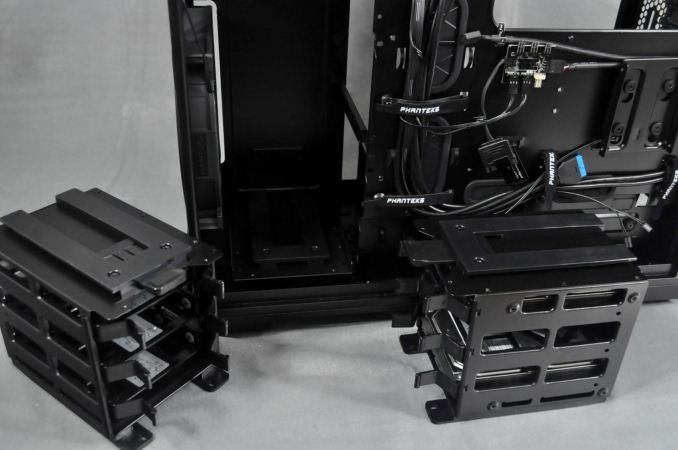
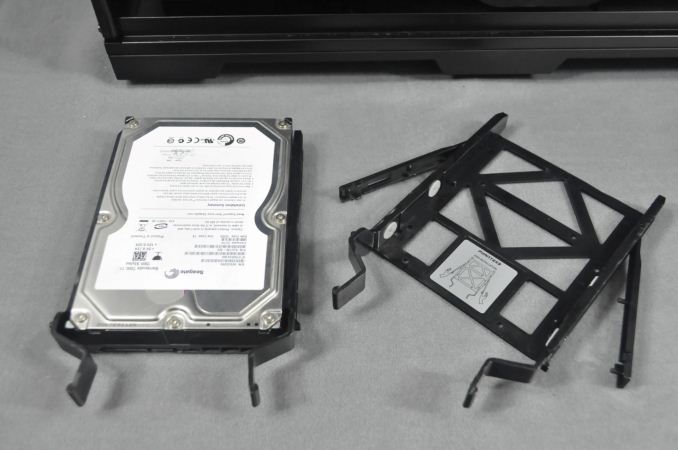
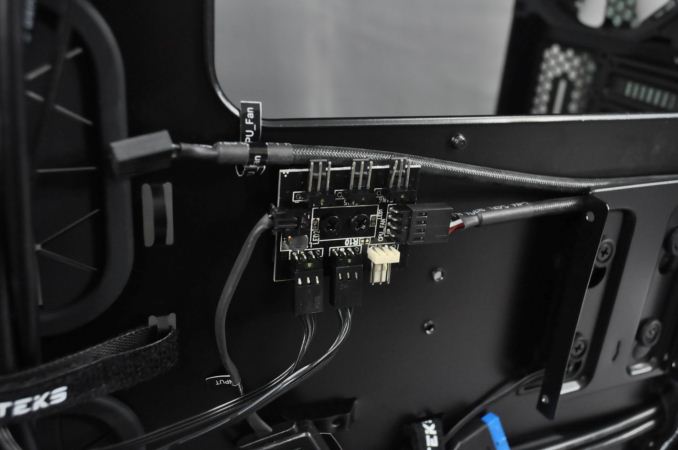






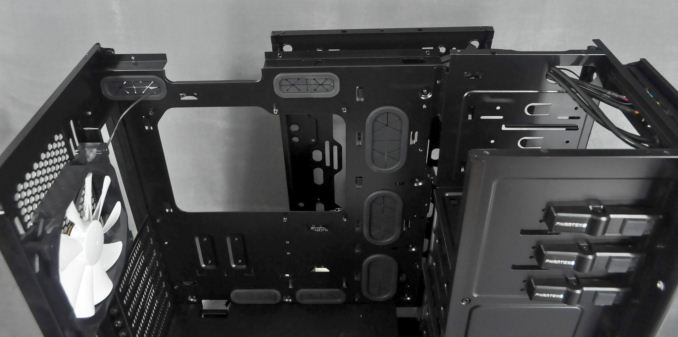
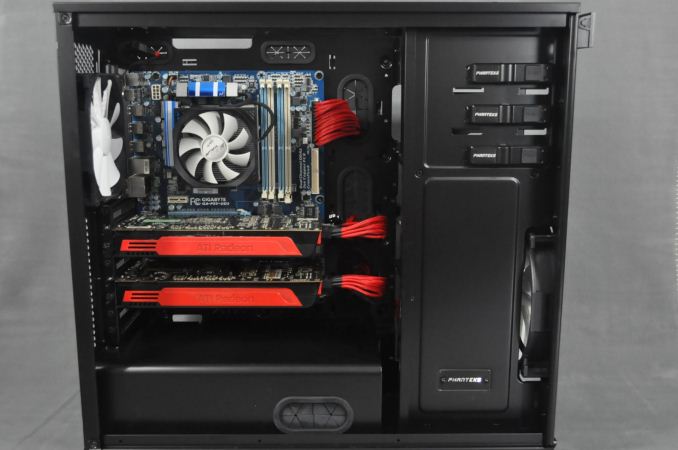








50 Comments
View All Comments
Haravikk - Wednesday, April 1, 2015 - link
Agreed. This case is incredibly unremarkable, and until more towers start ditching the obstructive and largely redundant up-front drive bays, we're not going to get much progress in the tower market.I don't know any gamers who really need more than two drives, or for whom 2.5" drives aren't sufficient. 4x 2.5" drive bays can squeeze in almost anywhere in a properly designed case, and would still let you have a pair of mirrored SSDs and mirrored HDDs (or striped if you prefer) which is about the most I expect anyone to have these days.
In terms of optical bays; so few people really use them anymore, meanwhile a slot-loading (or at least low profile) drive takes up hardly any space. The focus really does need to be on big fans up front with as little obstruction as possible.
Some people might mention fan controls, but any good pro case could include one with a custom fitting. But again, most people don't (or shouldn't) need a fan control, as any good motherboard can drive more than enough fans, so at most you might need a splitter cable, especially since most fans these days are pretty energy efficient, especially larger ones that don't need to spin very fast anyway.
So yeah, we're stuck with towers constantly being released with an obsolete internal design, and it's really hurting the market. Only smaller designs are really innovating at the moment, and even then some of them are making really weird decisions.
NLD - Wednesday, September 16, 2015 - link
You don't know because you don't know anyone... I'm a member of a gaming community and know over 50 in our community alone.....NLD - Wednesday, September 16, 2015 - link
get a laptop.Dug - Monday, March 30, 2015 - link
Define R5 lets you take all of them out giving you many options for radiators.NZXT S340 has no bays at all making the case fairly small for an ATX design.
nmm - Monday, March 30, 2015 - link
I would usually agree with you, but I tend to agree with some that the sentiment is more appropriate with compact cases. I just can't imagine there being a realistic need for a tower case with the entire front surface covered with radiators in addition to the top/bottom or whatever else. Just the same, I'd get more use out of a mini-fridge on the front of my case than 5¼" bays. That's because I'm not a person who has any need for a tower case, though. I'd rather build an efficient mini-ITX system than a 3 foot tall air circulator disguised as a computer.WithoutWeakness - Tuesday, March 31, 2015 - link
I think you're on to something with the mini fridge. Most cases with doors only have them to cover the ugly 5.25" bays. If we pull the 5.25" bays and replace them with a mini fridge that can hold a couple of cans then the door would actually have some functional purpose instead of just being for aesthetics.continuum - Tuesday, March 31, 2015 - link
Two went be plenty. Heck, lots of times, agreed that one would be enough, and zero is okay.Given it's an E-ATX case for $100 I don't mind seeing one or two (it's certainly big enough!) but yeah, three seems silly...
DanNeely - Wednesday, April 1, 2015 - link
Once you have a single 5.25 bay, you might as well have several, and a mess of 3.5" bays below, since you've stretched your case forward enough to accommodate them.The compact (front to back) single 5.25 bay case died when the market decided to move the PSU to the bottom and to use the top of the case for ventilation.
NLD - Wednesday, September 16, 2015 - link
5.25 bays are essential , Fan controllers, lighting controllers, Card drives, audio bays.... if you don't like them use the 100's of cases with no 5.25 bays.... I really think new cases need them, maybe more ascetics and innovation on how you can disguise or hide them is a good idea.Needless to say, fans of external Blu-ray players and DVD-HD writers etc... will not care but they are with good cases, 5.25 drive bays will live on.
nos024 - Monday, March 30, 2015 - link
I like my 5.25 bays...there has to be at least two. I am not ready to give up my ODD and swappable HDD bay. At least for large towers like this, I want to have 5.25 bays. I can see a mid tower case not having it. The point of a full tower case is that you can put ANYTHING you want in it.The problem with these large towers case is that the 8pin CPU power cord is barely long enough (and sometimes won't even reach). Given that the majority of PSUs are mounted at the bottom, I think it's time the PSU manufacture give you a longer cord...or the Motherboard manufacturers change it's location, or the case give you a better path. I see that this case has an opening at the top to route the cable to so it won't be a problem.